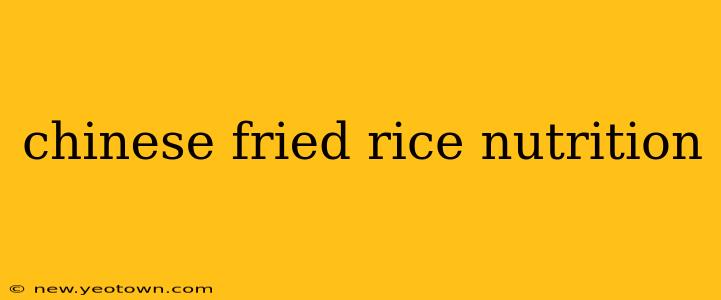Chinese fried rice. The very words conjure images of steaming plates, savory aromas, and a satisfying crunch. It's a global favorite, a staple in takeout menus, and a comforting dish enjoyed at home. But beyond the deliciousness, lies a nutritional story worth exploring. This isn't just about calories; it's about understanding the balance of nutrients, potential health benefits, and how to make informed choices when indulging in this culinary classic.
What are the main ingredients in Chinese fried rice?
The beauty of Chinese fried rice lies in its versatility. The foundation, however, usually involves cooked rice (often day-old, which helps prevent it from becoming mushy), vegetables (peas, carrots, onions, corn are common), and eggs. Protein sources vary wildly, from chicken and pork to shrimp and tofu. Soy sauce adds its characteristic salty-umami flavor and a touch of sodium. Finally, oil is used for stir-frying, often vegetable oil or sometimes sesame oil for extra flavor. The exact ingredients, however, can significantly impact the nutritional profile.
How many calories are in a serving of Chinese fried rice?
This is where things get tricky. A single serving of Chinese fried rice can range dramatically in calorie count, depending on portion size and ingredients. A typical restaurant serving might pack in anywhere from 400 to 800 calories or even more! Home-cooked versions, carefully portioned and with leaner protein sources and less oil, can certainly fall on the lower end of that spectrum. The key is portion control and mindful ingredient selection.
Is Chinese fried rice healthy?
The answer isn't a simple yes or no. Like most foods, it depends on the specifics. Chinese fried rice can be a source of carbohydrates from the rice, protein from the added ingredients, and vitamins and minerals from the vegetables. However, the high sodium content from soy sauce and potential use of generous amounts of oil can be drawbacks. The type of oil used also matters. Healthier choices include using less oil overall and opting for unsaturated fats like those found in vegetable or canola oil.
What are the health benefits of Chinese fried rice?
While it's not a superfood, Chinese fried rice can contribute positively to your diet if prepared thoughtfully. The vegetables provide essential vitamins and minerals, and the protein supports muscle growth and repair. The carbohydrates provide energy. However, these benefits are easily overshadowed by excessive sodium and unhealthy fats if not carefully prepared.
How can I make healthier Chinese fried rice?
Making healthier Chinese fried rice is entirely achievable. Here are some tips:
- Use brown rice: Opt for brown rice instead of white rice for added fiber.
- Load up on veggies: Maximize the vegetable content to boost the nutritional value.
- Choose lean protein: Select lean protein sources such as chicken breast, shrimp, or tofu.
- Reduce oil: Use a minimal amount of oil for stir-frying or try healthier cooking methods.
- Control sodium: Use low-sodium soy sauce or a combination of soy sauce and other seasonings to reduce salt intake.
- Portion control: Be mindful of your portion sizes to manage calorie intake.
Is Chinese fried rice good for weight loss?
Chinese fried rice can be incorporated into a weight-loss diet, but it requires careful planning. Because of its potential for high calorie and sodium content, it shouldn't be a daily staple. Focus on smaller portions, healthier ingredient choices, and mindful preparation.
Chinese fried rice, when prepared thoughtfully, can be a delicious and satisfying part of a balanced diet. By understanding the nutritional aspects and making conscious ingredient choices, you can enjoy this culinary delight without compromising your health goals. Remember, moderation and mindful preparation are key to enjoying this beloved dish responsibly.

